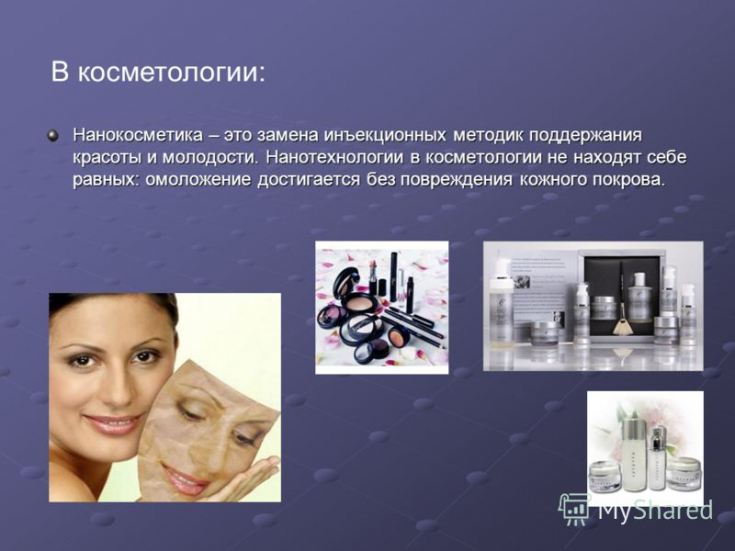At the moment, many methods have been developed for nanotechnology in modern medicine. One of the main – this is a targeted delivery of drugs to organs, tissues and cells that are affected by a certain process, the study of body systems using nanomarks, a discovery in the field of antiseptic agents (nanosilver, nanocopper, nanosilica, nanoiron).
Meanwhile, the achievements of modern medicine are being actively introduced in the field of cosmetology. Find out in our article on estet-portal.com what progressive methods of using these products will conquer the world of aesthetic medicine in the near future.
Nanotechnologies and modern medicine
The local action of drugs with the help of nanotechnology in modern medicine provides an active effect only on the site altered by the pathological process (skin, dermis, subcutaneous fat). In this way, much better results can be achieved than with traditional therapy, since the number of side effects due to a decrease in the concentration of substances is reduced, since in cosmetology the same products can have both a positive effect and an aggressive effect on the skin. Therefore, in modern medicine, it is so important to follow the instructions and instructions for the procedures.
Follow us on Instagram!
Nanotechnology can solve this problem, since microscopic molecules can contain the amount of active substances tens of times greater than their mass. Therefore, the creation of such a new "transport system" in cosmetology, according to scientists, will be the discovery of modern medicine in the near future.

Advances in modern medicine
Solid lipid particles, which are often used in nanotechnology, (SLN - solid lipid nanoparticles) are nanometer particles with a solid lipid matrix. These are oily lipid droplets that are solid at body temperature and stabilized with surfactants. Their production is quite simple and consists in replacing the liquid lipid of the nanoemulsion with solid lipids. SLNs have numerous benefits in modern medicine and cosmetic products.
You simply shine: effective skin lightening
They protect encapsulated ingredients from degradation. Compositions including coenzyme Q10 and retinol can remain stable in SLN for a long time. They can be used to target drug delivery over an extended period and improve the penetration of active ingredients into the stratum corneum.
Practical application of nanotechnologies in cosmetology
Nanotechnology-derived products are used in many cosmetic products, including moisturizing and restorative cosmetics for the face, hair care, makeup and sun protection. All major cosmetics manufacturers use nanomaterials in their products. According to the European Commission, 15% of cosmetic products contain nanoparticles.
Acid peeling and redermalization in the treatment of acne
The use of nanomaterials in cosmetic products is a subject of discussion, and the safety of such products is being studied. In cosmetic medicine today, two main areas of use of nanotechnology are known. The first is the use of nanoparticles as ultraviolet (UV) radiation filters. Titanium dioxide (TiO2) and zinc oxide (ZnO) are the main constituents of these products.

Second direction − delivery of drugs and cosmetics, for which liposomes, niosomes, solid lipid nanoparticles, nanostructured lipid carriers are used. The use of nanocrystals, nanomulsions, dendrimers in cosmetology is proposed.
Retinoids in dermatology: modern discoveries of drug action
Nanotechnologies in aesthetic medicine
Targeted drug delivery systems include numerous nanoscale complexes, historically the first of which were vesicular systems, primarily liposomes.
The most common class of targeted delivery systems in modern medicine and cosmetology are liposomes.
Liposomes (lat. Liposoma - lipid body) are artificial spherical particles obtained using nanotechnology, which consist of a bilayer of phospholipids (phosphatidylcholine, phosphatidylserine, phosphatidilethanolamine) surrounding the central water cavity and self-organizing during the phase transition due to the amphiphilic structure of lipids. The ability to form, under certain conditions, closed spherical bilayers, in addition to phospholipids, have amphiphilic natural and synthetic compounds - ceramides, fatty acids, lysolipids, etc.
The number of membrane layers can be different, which affects the size and structure of liposomes. Liposomes are single-layer, 25-50 nm in size (MOV - small unilamellar vesicles / SUV - small unilamellar vesicles) and > 50 nm (BOB
- large unilamellar vesicles / LUV - large unilamellar vesicles) multilayer (LSV - multilayer vesicles / MLV
- multilamellar vesicles), 100 nm - 3 µm in size.
Laser peeling to improve skin texture
In the cosmetic industry, liposomal preparations were first used in 1987-1988. Now products based on phospholipid vesicles are used as part of cosmetic formulations with a nourishing, regenerating, moisturizing effect, since due to such a structure and physical properties, cosmetic products have surprisingly high efficiency and less likelihood of adverse reactions. This is due to the fact that the concentration of substances to achieve a therapeutic effect on the skin is very small, since liposomes obtained by nanotechnology play the role of a "conductor" active substances directly into the affected areas of the skin.
This technology of targeted delivery of active substances to certain layers of the skin can become one of the most advanced in modern medicine and cosmetology.
Apparatus techniques for the treatment of photodamaged skin







Add a comment